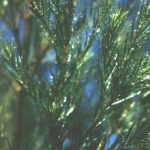| Common Name: |
Tea Tree |
| Botanical Name: |
Melaleuca alternifolia |
| Genus: |
Melaleuca |
| Family: |
Myrtaceae |
| Native Location: |
N Australia, S New Guinea, and the Moluccas |
| Cultivation: |
Moisture-retentive to wet, neutral to acid soil in sun; M. leucadendra tolerates light to saline soils. Pinch out young, pot growing plants to induce bushiness. |
| Propagation: |
By seed sown in spring at 13-24°C (55-75°F); by semi-ripe cuttings in summer. |
| Harvest: |
Oil is distilled from leaves and twigs, used directly, or in spirits and ointments. |
| Height: |
5-7m (15-22ft) |
| Width: |
3-5m (10-15ft) |
| Hardiness: |
Z9 |
| Extraction: |
Steam Distillation |
| Parts Used: |
Oil |
| Color and Odor: |
The essential oil is colorless with a fresh, sharp, pungent and camphorous aroma. |
| Background: |
Long used by the Australian aborigines for its medicinal properties. It was used by the British Colonists as a substitute brew for tea, hence its present name. Tea tree was introduced into European use in 1927. |
| Properties: |
Antiseptic, antibacterial, anti-fungal, stimulant, expectorant.
An aromatic, antiseptic herb that is expectorant, increases perspiration, and stimulates the immune system. It is effective against bacterial and fungus infections. |
| Medicinal Uses: |
Externally for yeast, vaginal infection, acne, athletes foot, plantar warts, warts, insect bites, cold sores, nits (eggs of head lice). May be applied directly to plantar warts, warts, and nits, but dilute with a carrier oil (such as almond oil) for other uses. |
| Economic Uses: |
Oil used in deodorants, soaps, antiseptic creams, mouthwashes, and toilet waters. |
| Uses: |
- Urinary System—Good for cystitis.
- Respiratory System—Valuable for colds and flu, relieving catarrh and sinusitis.
- Reproductive System—Good for all kinds of vaginal infections such as thrush. Also good for genital and anal itching.
- Skin—Very effective in clearing infected wounds, especially where there is pus. Tea tree is excellent for all types of skin problems, particularly those affecting the feet (ie Athlete's foot, corns, callouses, verrucas). Also good for warts and pierced ear and nail bed infections. An effective treatment for cold sores, shingles, and chicken pox. A good cleanser and deodorizer.
- Emotions—Tea tree is very clarifying and head clearing, cleansing the imagination of disturbing thoughts.
|
| Blends: |
| Bibliography: |
Aromatherapy Blends and recipes by Franzesca Watson Copyright © 1995 Thorsons, Harper Parker Publishing Inc. Pp 172-173
The Encyclopedia of Herbs by Deni Bown Copyright © 1995, 2001 Dorling Kindersley Limited. Pg. 273 |
|

